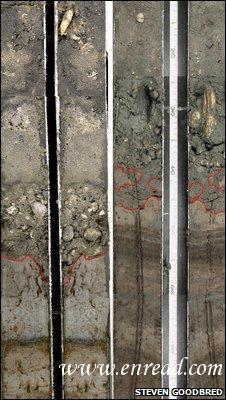| ||||||||||||||||||||||||||||||||||||||||||||||||||||||||||||||||||||||||||||||||||||||||||||||||||||||||||||||||||||||||||||||||||||||||||||||||||||||||||||||||||||||||
|
A huge wave crashed into the New York City region 2,300 years ago, dumping sediment1 and shells across Long Island and New Jersey2 and casting wood debris3 far up the Hudson River. 2300年前,一场巨大的飓风袭击了纽约市,在长岛和新泽西之间倾泻了大量的沉淀物和贝壳,吹来了遥远的哈德逊河流域树木的碎片。 Such a wave today would flood Wall Street and the Long Island Expressway The scenario4(情节,剧本), proposed by scientists, is undergoing further examination to verify radiocarbon dates and to rule out other causes of the upheaval(举起,隆起). Sedimentary(积淀) deposits(存款,堆积物) from more than 20 cores in New York and New Jersey indicate that some sort of violent force swept the Northeast coastal5 region in 300BC. It may have been a large storm, but evidence is increasingly pointing to a rare Atlantic Ocean tsunami6. Steven Goodbred, an Earth scientist at Vanderbilt University, said large gravel7(碎石), marine8 fossils and other unusual deposits found in sediment cores across the area date to 2,300 years ago. The size and distribution of material would require a high velocity9(高速度) wave and strong currents to move it, he said, and it is unlikely that short bursts produced in a storm would suffice(足够,合格). "If we're wrong, it was one heck of a storm," said Dr Goodbred. Unusual layers in sediment cores may be a sign of an ancient tsunami Landslide10 or asteroid11(小行星)? The origin of such a tsunami is also under debate. An undersea landslide is the most likely source, but one research group has proposed that an asteroid impact provided the trigger. In 300BC, barrier beaches and marsh12(沼泽,湿地) grass embroidered13(绣花的) the coast, and Native Americans walked the shore. Today, a wave of the proposed size would leave Wall Street and the Long Island Expressway awash(与水面齐平的,被浪冲打的) with salt water. An Atlantic tsunami was rare but not inconceivable(不可思议的), said Neal Driscoll, a geologist14 from Scripps Institution of Oceanography, who is not associated with the research. But verifying one that is 2,000 years old is tricky15. Earthquakes, underwater landslides16, or a combination of the two were the most frequent Atlantic tsunami triggers, said Professor Driscoll. The 1929 Grand Banks tsunami, in Newfoundland, which killed more than two-dozen people and snapped many transatlantic cables, was set in motion by a submarine landslide set off by an earthquake. Dr Goodbred imagines that the New York wave was on the Grand Banks scale - three to four metres high and big enough to leap over the barrier islands; but that it did not reach the magnitude(大小,级数) of the 2004 Sumatran tsunami. The evidence is buried under metres of sediment in New York and New Jersey. Some researchers suspect a space impactor may have been involved High-speed wave Dr Goodbred first proposed the link between the layers of unusual debris found in sediment cores and a tsunami while studying shellfish populations in Great South Bay, Long Island. He extracted many mud cores with incongruous(不协调的) 20cm layers of sand and gravel. Their age matched that of wood deposits buried in the Hudson riverbed and marine fossils in a New Jersey debris flow in cores gathered by other researchers. The fist-sized gravel he found in Long Island would require a high velocity(高速度) of water - well over a metre per second - to land where it did, said Dr Goodbred. Among the fossils and shells sandwiched in the organic black mud of Sandy Hook Bay, New Jersey, Marine Geologist Cecilia McHugh of Queens College, City University of New York, discovered mud balls made from red clay that matched iron-rich sediments17 found onshore. The balls form their spherical18(球形) shape only through vigorous(精力充沛的) reworking, said Dr McHugh, and they do not form in small storms. "I didn't think much about it until we dated the deposit and came up with the same date that Steve did on Long Island," she said. It prompted her to check cores extracted from the upper continental19 slope 200km offshore20. She discovered a 2,200-year-old layer of sand and mud, on top of sedimentary layers 8,000 to 14,000 years old. Dr McHugh says such relatively21 young debris is not found that far out on the slope, and the date is close to that of the New York and New Jersey samples. 点击  收听单词发音 收听单词发音
|
||||||||||||||||||||||||||||||||||||||||||||||||||||||||||||||||||||||||||||||||||||||||||||||||||||||||||||||||||||||||||||||||||||||||||||||||||||||||||||||||||||||||
- 发表评论
-
- 最新评论 进入详细评论页>>






